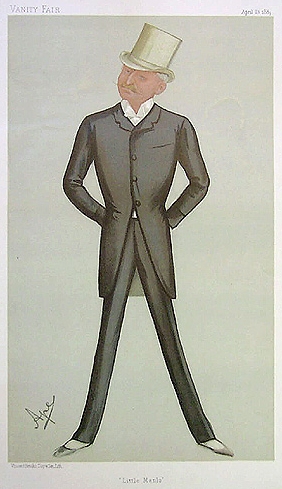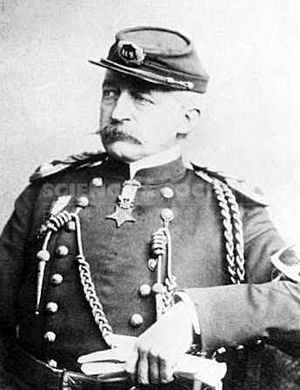George Edward Gouraud facts for kids
Quick facts for kids
George Edward Gouraud
|
|
|---|---|

Gouraud as caricatured by Ape (Carlo Pellegrini) in Vanity Fair, April 1889
|
|
| Born | June 30, 1842 Niagara Falls, New York |
| Died | February 20, 1912 (aged 69) Vevey, Switzerland |
| Allegiance | United States of America Union |
| Service/ |
United States Army Union Army |
| Years of service | 1861–1865 |
| Rank | Brevet Lieutenant Colonel |
| Unit | |
| Battles/wars | American Civil War *Battle of Honey Hill |
| Awards | Medal of Honor |
George Edward Gouraud (born June 30, 1842 – died February 20, 1912) was an important American figure. He earned the Medal of Honor during the American Civil War. Later, he became well-known for bringing Thomas Edison's amazing new Phonograph cylinder sound recording technology to England in 1888.
Contents
A Hero in the Civil War
George Gouraud was born in New York. His father, François Fauvel Gouraud, was a French engineer. He came to the US to introduce the Daguerreotype (an early type of photograph). Sadly, both of George's parents died in 1847, leaving him and his older sister orphaned.
George fought for the United States Army during the American Civil War, from 1861 to 1865. He showed great bravery as a captain. On November 30, 1864, he was awarded the Medal of Honor for his actions. This is the highest award for military bravery in the United States. He was later promoted to lieutenant colonel.
Working with Thomas Edison
After the war, Gouraud moved to London. He went there to help promote Edison's telegraph system. He first met Thomas Edison in 1874. Edison was in England to show off some of his new inventions.
Gouraud loved new electrical inventions. In the late 1880s, he filled his house in South London with many of Edison's gadgets. He even renamed his home "Little Menlo." This was a tribute to Menlo Park, New Jersey, where Edison had his famous research lab.
Introducing the Phonograph
In 1888, Thomas Edison sent his "Perfected" Phonograph to Gouraud in London. This was a machine that could record and play sounds. On August 14, 1888, Gouraud showed the phonograph to the public in London. He played a recording of music, including a song called "The Lost Chord." This was one of the very first music recordings ever made!
Gouraud held many parties at "Little Menlo" to introduce the phonograph to important people. Famous composer Arthur Sullivan (who wrote "The Lost Chord") attended one of these parties. He even recorded a message for Thomas Edison. Sullivan said he was "astonished" by the phonograph's power. He also joked that he was "terrified" that "hideous and bad music may be put on record forever." But he called it "the most wonderful thing" he had ever experienced.
Gouraud put together a small team of people to travel around England. They promoted the phonograph and recorded the voices of many famous people from that time. For example, in 1890, he arranged for three special recordings:
- On May 15, 1890, Alfred, Lord Tennyson, a famous poet, read his poem Charge of the Light Brigade.
- On July 30, 1890, Florence Nightingale, the famous nurse, recorded a message for soldiers from the Crimean War.
- On August 2, 1890, Martin Lanfried played a bugle that had been used at the Battle of Waterloo in 1815.
Later Life and Family
In 1898, Gouraud met Horace Short, who later became famous for aviation with his brothers. Gouraud helped pay for Horace's research into sound amplification. Their invention, called the Gouraudphone, was shown at a big exhibition in Paris in 1900.
Gouraud had an interesting family life. He married Florence Willis Snow in New York in 1870. They moved to London and had several children. After Florence died in 1907, he married Norwegian composer Helga Smith-Hald in 1909.
George Gouraud passed away in 1912 in Switzerland. Sadly, his son Bayard had died just a week before. Another son, Jackson Gouraud, became a ragtime songwriter. His son Powers Gouraud was a composer and a pioneer in broadcasting.
Images for kids



